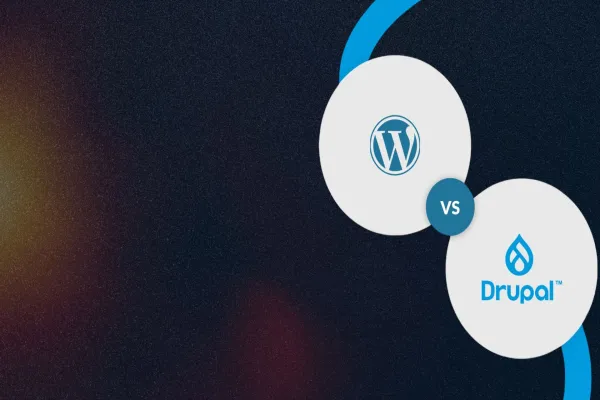Selecting the ideal Content Management System (CMS) is pivotal for midsize businesses aiming to balance scalability, flexibility, and cost-effectiveness. Among the myriad options, Drupal 11 stands out, but how does it compare to other popular CMS platforms like WordPress, Strapi, Prismic, Contentful, Optimizely, and Sanity? Here’s a complete analysis of the same.
Drupal 11: A Comprehensive Overview
Drupal 11 is renowned for its robustness, offering unparalleled customization, scalability, and security. Its modular architecture allows businesses to tailor their digital experiences precisely, making it a preferred choice for complex websites requiring intricate workflows and multilingual support. Drupal 11 offers unmatched flexibility with its open-source core, allowing businesses to build powerful, customized digital platforms. With strong community support, enterprise-grade security, accessibility compliance, and a modular architecture, it is built for long-term sustainability. The active module ecosystem and support for modern front-end frameworks ensure that your CMS stays aligned with digital marketing and SEO trends. However, its steep learning curve necessitates a skilled development team, which can be a consideration for some organizations.
Pros:
- Enterprise-level security with community-backed updates
- Flexible and API-first for headless setups
- Future-proof with regular innovation cycles
- Lower lifecycle cost due to open-source licensing and community modules
Cons:
- Requires a skilled development team to unleash its full potential
Drupal vs. WordPress: User-Friendly but Limited for Complex Needs
WordPress dominates the CMS market due to its ease of use and extensive plugin ecosystem. It's ideal for small to medium-sized websites, offering quick deployment and a vast community for support. However, for midsize businesses with complex requirements, It’s intuitive, highly extensible via plugins, and easy to deploy. For simple websites or small blogs, it’s often a great fit. WordPress may fall short in scalability and advanced customization. Security concerns also arise due to its popularity, making it a frequent target for attacks.
However, for midsize businesses, its weaknesses can surface:
- Performance and security depend heavily on third-party plugins
- Customization at scale can introduce complexity and risk
- Frequent plugin updates and patching can become a maintenance burden
While WordPress wins on simplicity, Drupal takes the lead in scalability and long-term maintainability.
Drupal vs. Strapi: Developer-Centric Flexibility
Strapi is an open-source headless CMS that provides developers with complete control over content delivery. Its API-first approach and support for modern frameworks like React and Vue make it attractive for custom applications. However, it lacks a built-in frontend, requiring additional development resources, and its plugin ecosystem is still maturing compared to Drupal's extensive module library.
Pros:
- Full developer control and customization
- Supports GraphQL and REST APIs
- Flexible for custom applications
Cons:
- Lacks a user-friendly interface for marketers
- No built-in frontend means higher development costs
- Missing out-of-the-box enterprise features like advanced permissions
Strapi is ideal for tech-heavy teams. But midsize businesses may find Drupal’s balance between customization and content-editor usability more practical.
Drupal vs. Prismic: Simplicity with Limitations
Prismic offers a user-friendly interface and is suitable for simple, content-focused websites. Its headless architecture allows for flexibility in frontend development. Prismic is a lightweight, SaaS-based headless CMS that’s great for content scheduling and easy publishing via its “Slice Machine” UI. Marketers love the intuitive workflow.
However, it may not be ideal for complex projects due to limited customization options and a less extensive feature set compared to Drupal.
Pros:
- Fast implementation and intuitive UI
- Efficient content reuse through slices
- Good for small marketing teams
Cons:
- Limited customization for complex workflows
- Heavy coding needed for advanced use cases
- Not ideal for large content-heavy ecosystems
Drupal, with its built-in multilingual, taxonomy, and workflow capabilities, caters far better to more structured content operations that midsize businesses often require.
Drupal vs. Webflow: Design-First Simplicity
Webflow is a no-code platform tailored for designers and marketers who want to build sleek websites without touching a line of code. Its intuitive drag-and-drop editor, built-in hosting, and visually-driven workflow make it a favorite for launching fast, beautiful websites. However, its limitations surface when complex logic, custom integrations, or enterprise workflows are required—areas where Drupal excels.
Pros:
- Visually intuitive design interface
- Built-in hosting and global CDN
- Fast deployment for landing pages and marketing sites
Cons:
- Limited customization for complex applications
- Less robust API and integration options
- Not ideal for managing large-scale content hierarchies
Webflow shines for rapid deployment and visual appeal. But when scalability, security, and content architecture matter—Drupal’s depth and flexibility make it the more future-proof choice.
Drupal vs. Contentful: Scalable but Costly
Contentful is a powerful headless CMS designed for delivering content across multiple platforms. Its API-driven approach and cloud-based infrastructure offer scalability and performance. Contentful is a powerhouse designed for omnichannel delivery. It plays well with developer stacks and integrates with a range of tools.
However, its pricing model can be prohibitive for midsize businesses, and it requires technical expertise for setup and maintenance.
Pros:
- API-first and developer-friendly
- Highly scalable
- Ideal for multichannel content delivery
Cons:
- High learning curve for marketers
- Expensive, especially at scale
- A/B testing and other enterprise tools are paid add-ons
Drupal 11, while technical, offers a more balanced cost structure and native capabilities out-of-the-box, helping midsize businesses avoid steep operational costs.
Drupal vs. Optimizely: Enterprise-Level Features with a Price Tag
Optimizely combines traditional and headless CMS capabilities, offering advanced personalization and experimentation tools. It's well-suited for enterprises seeking comprehensive digital experience platforms. Optimizely markets itself as a Digital Experience Platform (DXP), combining traditional and headless CMS features with AI, testing, and personalization.
However, its complexity and cost may not align with the needs and budgets of midsize businesses.
Pros:
- Hybrid CMS architecture
- Rich personalization and A/B testing tools
- Streamlined marketing workflows
Cons:
- Enterprise pricing model
- Implementation complexity
- Vendor lock-in risks
While feature-rich, Optimizely might be overkill for midsize businesses that need flexibility without the premium price tag. Drupal’s modular architecture allows for gradual enhancements—on your terms.
Drupal vs. Sanity: Real-Time Collaboration with a Learning Curve
Sanity provides real-time collaboration features and a flexible content model, making it suitable for dynamic content needs. Its GROQ query language and customizable editing environment offer developers significant control. However, the learning curve associated with its unique features may pose challenges for teams unfamiliar with its ecosystem.
Pros:
- Real-time editing and collaboration
- API-first and schema-less content model
- Omnichannel-ready
Cons:
- Requires technical ramp-up time
- Customization depends on developers
- Marketers may struggle with setup
Drupal offers comparable flexibility with a more mature ecosystem of tools and documentation, allowing for smoother collaboration between marketers and developers.
Final Verdict: Why Drupal Wins for Midsize Businesses
While each CMS offers unique strengths, Drupal 11 strikes the optimal balance midsize businesses need—scalability, security, flexibility, and cost-effectiveness. It avoids the oversimplification of WordPress and the overcomplexity or cost of enterprise-first platforms like Optimizely and Contentful.
Its open-source foundation ensures future-proofing, and the thriving Drupal community keeps it aligned with evolving digital marketing standards, SEO, accessibility, and modern development trends. While other CMS platforms offer specific advantages, Drupal's comprehensive feature set and active community support provide a robust foundation for complex digital experiences.





